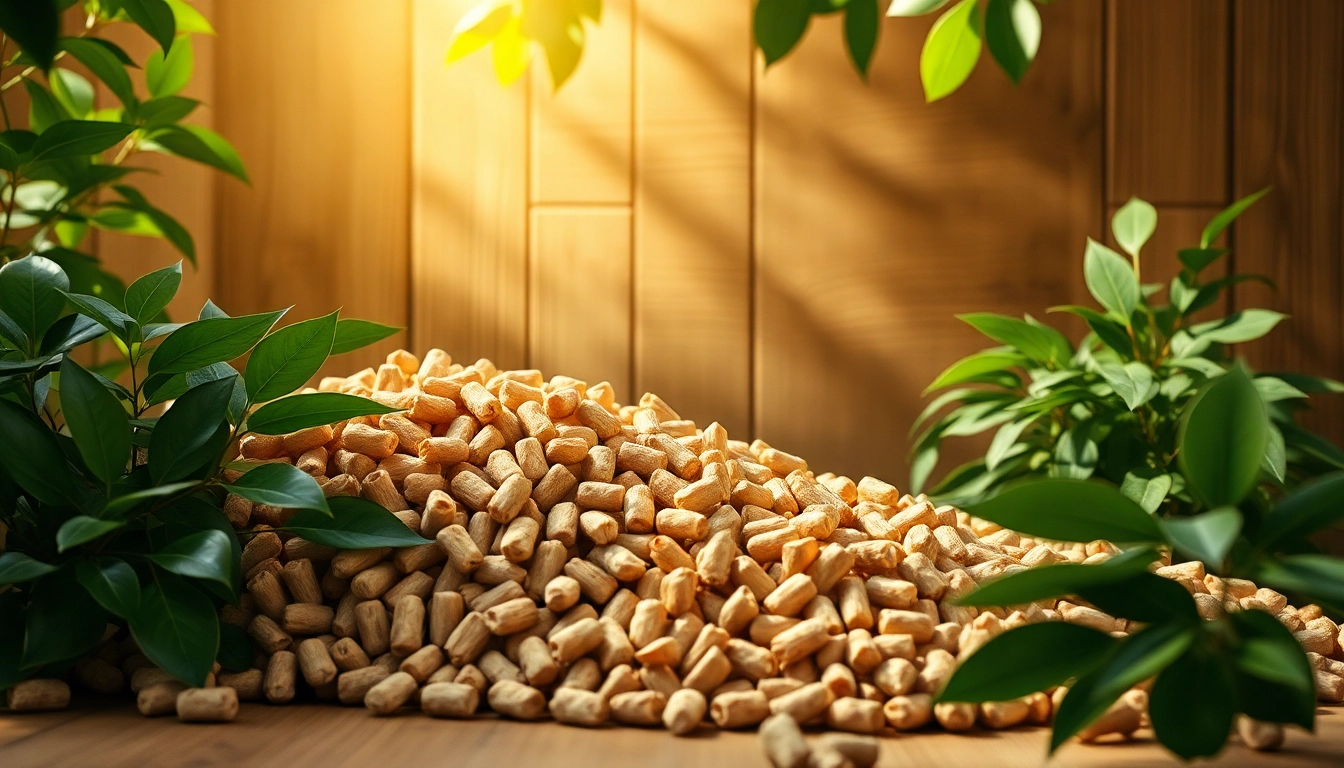Introduction to Pellets
Among the various fuel options available today, Pellets have emerged as a popular choice for both residential and industrial applications. Understanding the characteristics, advantages, and variety of pellets is crucial for consumers and businesses alike who are looking for viable energy solutions. This comprehensive guide aims to provide an in-depth exploration of pellets, including their types, applications, and environmental benefits.
What Are Pellets?
Pellets are small, cylindrical pieces of compressed organic material, commonly produced from wood, agricultural residues, or other biomass. Typically measuring between 6mm and 10mm in diameter and 1 to 5 centimeters in length, they are made through an extensive process that includes grinding the raw materials, drying them to a specific moisture content, and then compressing them under high pressure. This compression eliminates moisture while ensuring structural integrity, making pellets convenient for storage and transportation.
Historical Context and Usage
The use of pellets is not a novel concept; historically, people have sought efficient methods to utilize biomass for heating and cooking. However, modern wood pellets have evolved significantly since their introduction in the 1970s. Initially developed as a means of recycling wood waste, they quickly gained traction in residential heating applications, providing a cleaner alternative to traditional wood burning. Over the years, the adaptability of pellets has led to their incorporation in diverse sectors, from industrial energy production to barbecue cooking, broadening their appeal and application.
The Benefits of Pellets
Pellets offer various advantages that enhance their viability as a fuel source. Among these benefits are:
- High Energy Efficiency: Pellets boast a high calorific value compared to traditional firewood, making them an efficient option for heating.
- Reduced Emissions: Burning pellets results in fewer greenhouse gas emissions, contributing to a cleaner environment.
- Convenient Storage and Handling: Due to their uniform size and low moisture content, pellets can be easily stored and handled, requiring less space than logs.
- Cost-Effectiveness: The global increase in pellet production has led to more competitive pricing, often making them an economical heating solution.
Types of Pellets and Their Characteristics
Wood Pellets Overview
Wood pellets are the most prominent type of pellets and are primarily made from sawdust, wood shavings, and wood chips. They are manufactured from both softwood (such as pine or spruce) and hardwood (like oak or maple), each offering distinct characteristics:
- Softwood Pellets: Known for a higher heat output and lower ash content, softwood pellets are often preferred for residential heating.
- Hardwood Pellets: While they generally produce less heat, hardwood pellets yield a better-quality ash and are favorable in cooking applications.
The refinement process also greatly affects the quality of the pellets, as high-quality pellets should exhibit minimal moisture content (typically below 10%) and be free of contaminants.
Alternative Pellet Materials
While wood pellets dominate the market, alternative pellet materials have gained attention for their sustainability and accessibility. Some noteworthy examples include:
- Agricultural Pellets: Made from crops like corn stover, wheat straw, and barley, these pellets utilize agricultural residues and promote waste reduction.
- Biomass Pellets: These encompass a variety of organic materials, including herbaceous plants and energy crops, contributing to diversified fuel options.
- Plastic Pellets: Innovations in recycling have led to the production of pellets from plastic waste, targeting the reduction of landfill waste.
Comparing Different Pellet Types
When selecting pellets for a specific application, it is essential to compare the various types based on several criteria:
- Burning Efficiency: Wood pellets typically burn hotter and longer than agricultural pellets.
- Ash Production: Hardwoods tend to produce finer ash, making cleanup easier.
- Availability and Cost: Assess regional availability, as certain types may be more accessible and economically viable than others.
Ultimately, the choice of pellets should align with the intended use, whether for heating, cooking, or industrial applications.
Applications of Pellets in Everyday Life
Heating Solutions with Pellets
In residential settings, pellet stoves and boilers provide effective heating solutions, leveraging the high energy output of pellets while minimizing emissions. These systems are designed to deliver heat in a controlled manner, allowing homeowners to maintain comfortable indoor temperatures efficiently. The convenience of automatic feed systems allows for continuous burning, meaning less effort in managing fuel supply.
Pellets in Industrial Applications
Beyond residential use, pellets have significant industrial applications, particularly in power generation. Power plants increasingly utilize wood pellets as a renewable energy source to replace coal in energy production, thus meeting regulatory standards for emissions. Furthermore, pellets can be employed in various manufacturing processes, offering an eco-friendly option for energy-intensive industries.
Use of Pellets in Cooking
Grilling and smoking enthusiasts highly regard wood pellets for their flavor-enhancing properties in outdoor cooking. These pellets, often infused with specific wood types like hickory or mesquite, add unique flavors to foods. Culinary applications extend to indoor cooking methods, including pellet smokers and ovens, providing versatility for any cooking setting.
Eco-Friendly Impact of Pellets
Renewable Energy Aspect
Pellets contribute to renewable energy initiatives by providing a sustainable alternative to fossil fuels. Using biomass—an organic material that can be replenished—reduces dependence on non-renewable resources, contributing to a more sustainable energy grid.
Carbon Footprint of Pellets
When burned, pellets release carbon dioxide; however, this is offset by the CO2 absorbed during the growth of the biomass. This cycle makes the usage of pellets environmentally favorable compared to traditional fossil fuels, as it helps close the carbon loop.
Sustainable Sourcing Practices
To ensure the eco-friendliness of pellets, sustainable sourcing practices are critical. This includes responsible forestry management, utilizing waste materials rather than virgin resources, and implementing certifications standards such as the Sustainable Forestry Initiative (SFI) and the Forest Stewardship Council (FSC). Such practices promote biodiversity while ensuring a stable supply of raw materials over the long term.
Future of Pellets in Energy Production
Technological Innovations in Pellet Production
The pellet industry is continually evolving through technological advancements that enhance production efficiency and environmental impact. Innovations include automated production lines that optimize energy usage, as well as improvements in pellet durability that reduce transport emissions. The development of hybrid systems that combine wood pellets with other renewable sources is also gaining attention, paving the way for a more integrated energy portfolio.
Market Trends and Predictions
The market for pellets is projected to see substantial growth driven by increasing global energy demands and the pivot toward renewable energy solutions. Factors influencing this trend include government incentives for renewable energy, growing consumer awareness about climate change, and escalating costs of fossil fuels. As the demand rises, so too does the push for innovation in biomass processing and efficiency improvements.
Potential Challenges and Solutions
The pellet industry is not without its challenges. Key issues include supply chain sustainability, competition with food crops, and varying regulatory environments across regions. Addressing these challenges requires collaborative efforts among stakeholders, including policy-makers, industry leaders, and environmental organizations. Strategies such as enhancing infrastructure for transportation and storage, improving overrides for eco-labeling, and investing in public awareness campaigns can lead to a more robust and resilient pellet market.
In conclusion, Pellets represent a promising alternative to traditional fuels, offering numerous advantages in efficiency, reduced emissions, and sustainability. As the world shifts toward renewable energy solutions, understanding and optimizing pellet usage remains a critical endeavor for future energy strategies.



